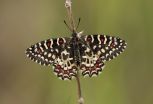(Press-News.org) You don't think you're hungry, then a friend mentions how hungry he is or you smell some freshly baked pizza and whoaaa, you suddenly feel really hungry. Or, you've had surgery and need a bit of morphine for pain. As soon as you hit that button you feel relief even though the medicine hasn't even hit your bloodstream.
These are two examples of the oft-studied placebo effect that demonstrate the amazing and still somewhat confounding powers of the human brain.
Now, CU-Boulder graduate student Scott Schafer, who works in Associate Professor Tor Wager's Cognitive and Affective Neuroscience Lab in the Department of Psychology and Neuroscience, has conducted an intriguing piece of research to advance knowledge about how and when the placebo effect works - or doesn't.
In short, he discovered that the placebo effect still works even if research participants know the treatment they are receiving to ease pain has no medical value whatsoever.
Here's the hitch: The subjects need ample time - in this case four sessions - to be conditioned to believe the placebo works. Then, even after it is revealed that the treatment is fake, they continue to get pain relief. When participants are told the truth about the treatment after only one session, they don't show a continued placebo effect.
The findings suggest that reinforcing treatment cues with positive outcomes can create placebo effects that are independent of reported expectations for pain relief. Wager, the senior author of the study, explains: "We're still learning a lot about the critical ingredients of placebo effects. What we think now is that they require both belief in the power of the treatment and experiences that are consistent with those beliefs. Those experiences make the brain learn to respond to the treatment as a real event. After the learning has occurred, your brain can still respond to the placebo even if you no longer believe in it."
Schafer, Wager, and co-author Luana Colloca, of the University of Maryland Baltimore, had their paper "Conditioned Placebo Analgesia Persists When Subjects Know They Are Receiving a Placebo" published in the May issue of The Journal of Pain, a peer-reviewed scientific publication.
Schafer, 33, said his advisor helped him refine his area of research around placebos.
"My general interests are specifically in how we learn to predict the environment around us," he said. "Digging into how placebos occur and when and why they arise is really interesting."
To conduct the research, Schafer and Colloca applied a ceramic heating element to research subjects' forearms. They applied enough heat to induce strong pain sensations, though not enough to burn the skin.
Interestingly, Schafer ended up having to turn some potential test subjects away because of a higher than normal pain tolerance on their forearms. Turns out, some of these people were food servers accustomed to carrying hot plates of food to hungry diners.
After applying heat of up to 117.5 degrees Fahrenheit to the research subjects who passed the initial screening, Schafer applied what the subject thought was an analgesic gel on the affected skin then - unbeknownst to the research subject - turned down the temperature. To aid in the charade, the subject was asked to read drug forms and indicate whether they had liver problems or were taking other medications prior to receiving the treatment..
In fact, the treatment was Vaseline with blue food coloring in an official-looking pharmaceutical container.
"They believed the treatment was effective in relieving pain," Schafer said. "After this process, they had acquired the placebo effect. We tested them with and without the treatment on medium intensity. They reported less pain with the placebo."
For Schafer, the research findings could open doors to new ways to treat drug addiction or aid in pain management for children or adults who have undergone surgery and are taking strong and potentially addictive painkillers.
"If a child has experience with a drug working, you could wean them off the drug, or switch that drug a placebo, and have them continue taking it," Schafer said.
Schafer believes the brain plays a key role in subjects for whom the placebo gel worked, and that more research is warranted.
"We know placebos induce the release of pain-relieving substances in the brain, but we don't yet know whether this expectation-independent placebo effect is using the same or different systems," Schafer said.
INFORMATION:
Contact:
Tor Wager, tor.wager@colorado.edu
Scott Schafer, scott.schafer@colorado.edu
303-492-4299
Jim Scott, CU-Boulder media relations, james.scott@colorado.edu
303-492-3114
Julie Poppen, CU-Boulder media relations, julie.poppen@colorado.edu
303-492-4007
The health of Colorado's bighorn sheep population remains as precarious as the steep alpine terrain the animals inhabit, but a new study led by researchers at the University of Colorado Boulder has found that inbreeding--a common hypothesis for a recent decline--likely isn't to blame.
Bighorn herds tend to be small and isolated in their mountain ecosystems, putting the animals at high risk for a genetic "bottleneck," said Catherine Driscoll, a graduate student in the Department of Ecology and Evolutionary Biology at CU-Boulder and lead author of the study. Previous research ...
As well as the daily strain of their working lives, shift workers are probably also more likely than other people to develop cancer. While this has been well described for breast cancer, few studies had examined the correlation between shift work and prostate cancer. In a recent original article in Deutsches Ärzteblatt International (Dtsch Arztbl Int 112: 463-70), Gael P. Hammer et al. show that shift workers do not develop prostate cancer more frequently than their colleagues who work during the day.
Shift work is widespread: between approximately one in five and ...
CAMBRIDGE, Mass. -- John Leonard's group in the MIT Department of Mechanical Engineering specializes in SLAM, or simultaneous localization and mapping, the technique whereby mobile autonomous robots map their environments and determine their locations.
Last week, at the Robotics Science and Systems conference, members of Leonard's group presented a new paper demonstrating how SLAM can be used to improve object-recognition systems, which will be a vital component of future robots that have to manipulate the objects around them in arbitrary ways.
The system uses SLAM ...
This news release is available in Spanish.
Since 2006, the team of researchers has sequenced the mitochondrial DNA of all the known species of butterflies in the Iberian peninsula (228) and its main populations. The result is a report that compiles more than 3500 genetic sequences of all the species, which have been compared to the genetic sequences of other European populations. The paper has 277 pages of supplementary material, including pictures and 80 maps of the geographical distribution of the butterfly genetic lineages identified.
This is the first time ...
(Philadelphia, PA) - Patients who have lower extremity proximal deep vein thrombosis (LE-DVT), or a blood clot in their leg, are increasingly undergoing minimally invasive catheter-based blood clot removal - also referred to as catheter-directed thrombolysis (CDT) - rather than solely being treated with traditional blood-thinning medications (anticoagulation alone). This trend is due to recent literature showing reductions in lifestyle-limiting post-thrombotic complications of acute DVT in patients who undergo CDT compared to those that are treated with anticoagulation ...
This news release is available in German.
Pathogenic bacteria develop killer machines that work very specifically and highly efficiently. Scientists from the University of Freiburg have solved the molecular mechanism of a fish toxin that could be used in the future as a medication to treat cancer. The scientists have now published their research in the journal Nature Communications.
The Yersinia species of pathogens can cause the bubonic plague and serious gastrointestinal infections in humans. The pharmacologist Dr. Thomas Jank and his fellow researchers in the ...
La Jolla, Calif., July 23, 2015 - A new study by researchers at Sanford Burnham Prebys Medical Discovery Institute (SBP), the National Cancer Institute, and the Chulabhorn Research Institute has found that blocking the activity of a key immune receptor, the lymphotoxin-beta receptor (LTβR), reduces the progression of liver cancer. The results, published today in the online edition of Gut, could provide new treatment strategies for the disease, which is the third leading cause of cancer-related deaths worldwide.
"Our findings point to a new way to improve the treatment ...
After decades of overtreatment for low-risk prostate cancer and inadequate management of its more aggressive forms, patients are now more likely to receive medical care matched to level of risk, according to a study by researchers at UC San Francisco.
In the first study to document updated treatment trends, researchers found that from 2010 to 2013, 40 percent of men with low-risk prostate cancer opted for active surveillance, in which the disease is monitored closely with blood tests, imaging studies and biopsies. Treatment is deferred unless these tests show evidence ...
Today an international team of astronomers from NASA's Kepler mission have announced the discovery of a near-Earth-sized planet in the habitable zone of a Sun-like star.
Dr Daniel Huber from the University of Sydney's School of Physics is part of the team which made the discovery with NASA's Kepler Space Telescope.
The planet named Kepler-452b is 60 per cent larger than Earth and orbits a Sun-like star with an orbital period of 385 days.
The mere 20 day difference between the planet's orbital period and that of Earth's makes it the closest analogue to Earth ever ...
EU's grid connected cumulative capacity in 2014 reached 129 GW, meeting 8% of European electricity demand, equivalent to the combined annual consumption of Belgium, the Netherlands, Greece and Ireland. According to a JRC report, the impressive growth of the industry will allow at least 12% electricity share by 2020, a significant contribution to the goal of the European energy and climate package of 20% share of energy from renewable sources.
The 2014 JRC wind status report presents the technology, market and economics of the wind energy sector with a focus on the EU. ...



